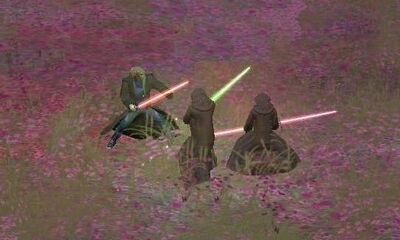
Lightsaber combat on Dantooine
Lightsaber combat was the preferred style of fighting used by the Jedi and Sith. The lightsaber was more than just the distinctive weapon of the Jedi, it was a segment of the order's history and its ultimate symbol for millennia. There could be no Jedi without a lightsaber and no lightsaber without a Jedi in the eyes of galactic denizens. Over the years, it came to be associated with gallantry and elegance otherwise lost in an age of blasters. Jedi traditionally constructed their own lightsaber as part of their training. To carry a lightsaber was an example of incredible skill and confidence, dexterity and attuning to the Force. Since its plasma blade was essentially weightless, the weapon produced a gyroscopic effect, and so it was very difficult to handle safely. Yet this made the weapon ideal for force-sensitive users whose ability to predict the various energy pulsations through the force allowed him or her to compensate for them. They also served as a means by which a Jedi's focus was attuned to the force during combat. For the same reason, it was also a very quick weapon, and superhuman reaction times were necessary to capitalize fully on this advantage. Only a handful of non-Force Sensitives have been known to master it, and none of them has ever presented a challenge for a fully-trained Jedi, save the lethally effective General Grievous.
The Seven Forms in SWG Terms[]
Each Jedi chose the style of lightsaber combat that best suited him or her. For example, Master Yoda used the Ataru form to compensate for his lack of reach and height; Mace Windu used Vaapad to tap into his anger and employ it constructively (albeit without giving himself over to the dark side); Count Dooku's practice of the Makashi form fit first of all his intention to frequently engage in lightsaber-to-lightsaber combat, and second his emphasis on class and elegance as well as precision.
In game terms, the seven forms are represented by the following Force Sensitive powers:
- Form I: Shii-Cho "Way of the Sarlacc" or "Determination Form" by Shii-Cho Stance
- Form II: Makashi "Way of the Ysalamiri" or "Contention Form" by Makashi Focus
- Form III: Soresu "Way of the Mynock" or "Resilience Form" by Soresu Stance
- Form IV: Ataru "Way of the Hawk-Bat" or "Aggression Form" by Ataru Focus
- Form V: Shien / Djem So "Way of the Krayt Dragon" or "Perseverance Form" by both Shien Stance and Djem So Focus
- Form VI: Niman "Way of the Rancor" or "Moderation Form" by Niman Stance
- Form VII: Juyo / Vaapad "Way of the Vornskr" or "Ferocity Form" by both Juyo Focus and Vaapad Focus
It should be evident that these forms I-VII are not a linear progression; that is, while Form VII Vaapad (CL90) is deadlier than Form II Makashi (CL14) in game terms, Form III Soresu (CL70) is deadlier than Form VII Juyo (CL62). Rather, the in-game forms are supposed to reflect different ways of using the Force in combat.
Two Makashi in SWG??[]
Of note is Form II Makashi. In the game it is represented by both Makashi Focus, a CL14 attack focus, and Makashi Stance, a defensive stance granted at CL54 that increases one's defense by 540. It is unclear why Makashi is given two totally distinct manifestations in the game, unless it is because Makashi was always a duelist specialty and it was thought that a defensive feat should be named after it as well.
